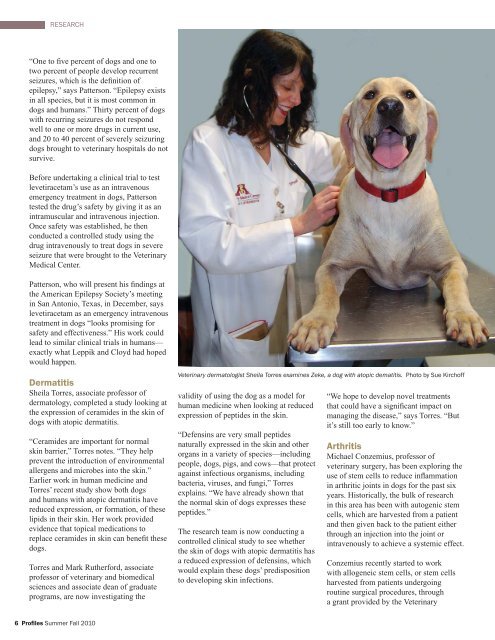Summer/Fall 2010 PDF Version - University of Minnesota College of ...
Summer/Fall 2010 PDF Version - University of Minnesota College of ...
Summer/Fall 2010 PDF Version - University of Minnesota College of ...
Create successful ePaper yourself
Turn your PDF publications into a flip-book with our unique Google optimized e-Paper software.
RESEARCH<br />
“One to five percent <strong>of</strong> dogs and one to<br />
two percent <strong>of</strong> people develop recurrent<br />
seizures, which is the definition <strong>of</strong><br />
epilepsy,” says Patterson. “Epilepsy exists<br />
in all species, but it is most common in<br />
dogs and humans.” Thirty percent <strong>of</strong> dogs<br />
with recurring seizures do not respond<br />
well to one or more drugs in current use,<br />
and 20 to 40 percent <strong>of</strong> severely seizuring<br />
dogs brought to veterinary hospitals do not<br />
survive.<br />
Before undertaking a clinical trial to test<br />
levetiracetam’s use as an intravenous<br />
emergency treatment in dogs, Patterson<br />
tested the drug’s safety by giving it as an<br />
intramuscular and intravenous injection.<br />
Once safety was established, he then<br />
conducted a controlled study using the<br />
drug intravenously to treat dogs in severe<br />
seizure that were brought to the Veterinary<br />
Medical Center.<br />
Patterson, who will present his findings at<br />
the American Epilepsy Society’s meeting<br />
in San Antonio, Texas, in December, says<br />
levetiracetam as an emergency intravenous<br />
treatment in dogs “looks promising for<br />
safety and effectiveness.” His work could<br />
lead to similar clinical trials in humans—<br />
exactly what Leppik and Cloyd had hoped<br />
would happen.<br />
Dermatitis<br />
Sheila Torres, associate pr<strong>of</strong>essor <strong>of</strong><br />
dermatology, completed a study looking at<br />
the expression <strong>of</strong> ceramides in the skin <strong>of</strong><br />
dogs with atopic dermatitis.<br />
“Ceramides are important for normal<br />
skin barrier,” Torres notes. “They help<br />
prevent the introduction <strong>of</strong> environmental<br />
allergens and microbes into the skin.”<br />
Earlier work in human medicine and<br />
Torres’ recent study show both dogs<br />
and humans with atopic dermatitis have<br />
reduced expression, or formation, <strong>of</strong> these<br />
lipids in their skin. Her work provided<br />
evidence that topical medications to<br />
replace ceramides in skin can benefit these<br />
dogs.<br />
Torres and Mark Rutherford, associate<br />
pr<strong>of</strong>essor <strong>of</strong> veterinary and biomedical<br />
sciences and associate dean <strong>of</strong> graduate<br />
programs, are now investigating the<br />
Veterinary dermatologist Sheila Torres examines Zeke, a dog with atopic dematitis. Photo by Sue Kirch<strong>of</strong>f<br />
validity <strong>of</strong> using the dog as a model for<br />
human medicine when looking at reduced<br />
expression <strong>of</strong> peptides in the skin.<br />
“Defensins are very small peptides<br />
naturally expressed in the skin and other<br />
organs in a variety <strong>of</strong> species—including<br />
people, dogs, pigs, and cows—that protect<br />
against infectious organisms, including<br />
bacteria, viruses, and fungi,” Torres<br />
explains. “We have already shown that<br />
the normal skin <strong>of</strong> dogs expresses these<br />
peptides.”<br />
The research team is now conducting a<br />
controlled clinical study to see whether<br />
the skin <strong>of</strong> dogs with atopic dermatitis has<br />
a reduced expression <strong>of</strong> defensins, which<br />
would explain these dogs’ predisposition<br />
to developing skin infections.<br />
“We hope to develop novel treatments<br />
that could have a significant impact on<br />
managing the disease,” says Torres. “But<br />
it’s still too early to know.”<br />
Arthritis<br />
Michael Conzemius, pr<strong>of</strong>essor <strong>of</strong><br />
veterinary surgery, has been exploring the<br />
use <strong>of</strong> stem cells to reduce inflammation<br />
in arthritic joints in dogs for the past six<br />
years. Historically, the bulk <strong>of</strong> research<br />
in this area has been with autogenic stem<br />
cells, which are harvested from a patient<br />
and then given back to the patient either<br />
through an injection into the joint or<br />
intravenously to achieve a systemic effect.<br />
Conzemius recently started to work<br />
with allogeneic stem cells, or stem cells<br />
harvested from patients undergoing<br />
routine surgical procedures, through<br />
a grant provided by the Veterinary<br />
6 Pr<strong>of</strong>iles <strong>Summer</strong> <strong>Fall</strong> <strong>2010</strong>

















